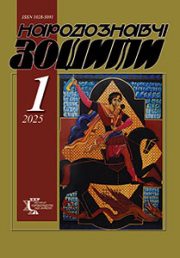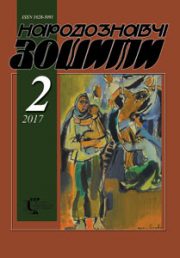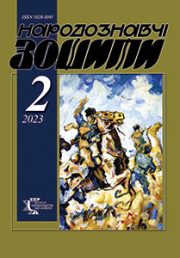The Ethnology Notebooks. 2019, № 6 (150), 1557—1562
UDK392.51:78.03(477.82)
DOI https://doi.org/10.15407/nz2019.06.1557
SACRED AND PROFANE IN THE TRADITIONAL WEDDING RITUAL OF WESTERN VOLYN: FORMS AND FUNCTIONS
SHVORAK Inna
ORCID ID: https://orcid.org/0000-0002-3803-1289
Applicant of the National Academy
of Senior Specialists of Culture and Arts
str. Lavra, 9, Kyiv, 02000
Contacts: e-mail: Inna.folk@gmail.com
Abstract. Introduction: The mythology of the folk-ritual culture of Ukrainians is a multilevel deep structure that contains various forms of representation and interaction with the world: from beliefs in supernatural forces to tales and legends; from life on the natural-seasonal calendar — to the creation of strict rules of social and public order; from the sacralization of one’s life to its profanation. Despite the constant change of life landmarks in the modern world, the last pair of relationships (sacred — profane) has proved to be the most stable in time and continues to exist in similar forms: sacred and worldly, holy and not holy, festive and everyday. These oppositional structures cannot be synonymous with one another, although certain aspects of them are often interspersed. The article deals with the functioning of the opposition sacral-profane structure in the wedding ceremony of one of the West Volyn subregions — Poturia. Problem Statement: The forms of sacral and profane in the traditional culture of Ukrainians have strong roots and most often form a complex opposition structure that is part of mythological consciousness. The purpose of the article is to study a sacred-profane sphere in Poturia wedding ceremony — one of a historical and ethnographic subareals of Western Volyn. Methods: The research methodology is based on the system-structured and integrative approaches. Conclusions: The sacred dimension of space and time in the wedding ritual leaves a little room for the manifestation of the secular world. However, the profane sometimes becomes a part of the wedding act and is generally associated with moments of denial / interruption of sacred reality, and mainly with festive and entertaining moments in the form of carnivalization of reality. The profane sphere in the wedding ceremony does not have clearly expressed forms, but its individual elements can temporarily «destroy» the sacredness.
Keywords: opposition «sacred-profane», wedding ceremony, Poturia, sacred space, sacred time, sacralization, profanation.
Received 5.11.2019
REFERENCES
Afonina, O.S. (2018). Сultural code and «dual coding». (Doctoral dissertation). The National Academy of Senior Specialists of Culture and Arts [in Ukrainian].
Borshch, O. (2012). Opposition «sacred‑profane» as a factor in the dynamics of cultural space. Gerald of the National Academy of Senior Specialists of Culture and Arts, 4, 59—63 [in Ukraine].
Voievodina, L. (2016). Sacred and profane in traditional culture. Vestnyk MNUKI. Fylosofyia kultury, 6 (74), 39—44 [in Russian].
Havryliuk, T.V. (2003). Sacred Space and Time as Mediator of the Natural and Supernatural World. Mythological Space and Time in Modern Culture (Proceedings of the International Scientific Conference). Kyiv [in Ukrainian].
Herchanivska, P. (2017). Culture in the paradigms of the XX—XXI centuries. Kyiv [in Ukrainian].
Diurkhaim, E. (2002) Initial forms of religious life: the totemic system in Australia. Kyiv: Yunivers [in Ukrainian].
Eliade, M. (1994). Sacred and worldly. Moscow: Izdatelstvo MHU [in Russian].
Kaiua, R (2003). Man and sacred. Kyiv: Vakler [in Ukrainian].
Kurakyn, D. (2011) Elusive sacred: the problem of the ambivalence of the sacred and its significance for the «strong program» of cultural sociology. Sotsyolohycheskoe obozrenye, 3, 41—70 [in Russian].
Leshchenko, A. (2016). The sacred space of the Christian mystery. Hileia: Naukovyi visnyk (Issue 106, pp. 261—264) [in Ukrainian].
Mykhailo, Iu (2015). Sacred as a phenomenon of culture. Relihiia ta sotsium, 3 (19), 149—156 [in Ukrainian].
Nesen, I. (2005). Wedding ritual of the Central Polissia: traditional structure and relict forms (middle of XIX—XX centuries). Kyiv [in Ukrainian].
Otto, R. (2008). Sacred: about the irrational in the idea of the divine and its relationship with the rational. Sankt-Peterburh: Izdatelstvo SPbHU [in Russian].
Pavlova, O. (2010). Cultural studies of reconstruction Genesis: the first syncretism of mif is holy. Kultura i suchasnist, 2, 5—9 [in Ukrainian].
Sumchenko, I. (2010). Features of perception of space and time in traditional culture. Doksa: zbirnyk naukovykh prats z filosofii ta filolohii. Universalni vymiry kultury (Issue 15, pp. 303—312) [in Ukrainian].
Fedorovskykh, A. (2000). The transformation of the sacred and the profane in society: myth — religion — ideology. The thesis for the academic degree of Candidate of Philosophy. Uralskiy gosudarstvennyiy universitet im. A.M. Gorkogo. Ekaterynburh [in Russian].
Chekan, O. (1999). Artistic space of musical work: genesis and functioning. (Candidate dissertation). Nizhynskyi derzhavnyi pedahohichnyi universytet im. M. Hoholia [in Ukrainian].
Sheliuto, V. (2010). The problem of the sacral as a worldview problem. Nauka. Relihiia. Suspilstvo, 4, 94—101 [in Ukrainian].
Leeuw, G. (1933). Phenomenologie der religion. Tьbingen: Paul Siebeck [in German].






